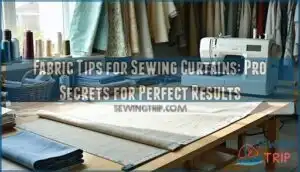This site is supported by our readers. We may earn a commission, at no cost to you, if you purchase through links.
Not all thick textiles come with wonderful colors and charming styles. Sometimes you need to count on thin materials to obtain the look you want. That is where having a little experience as well as a couple of techniques up your sleeve came in useful.
Exactly how to thicken fabric: That charming cotton pattern you simply acquired need to turn right into an ice cozy sweatshirt or other cool-weather apparel. The issue is that it is too thin. All you need to do is discover the ideal density of fleece to thicken the cotton up.
To discover out even more regarding enlarging various fabrics or their devices just remain to review our write-up. It offers you with useful info making your sewing life more satisfying and simpler to do.
Table Of Contents
Can You Thicken Fabric Paint?
This can be done and also it is not a difficult process. There are enlarging representatives you can buy that are created to function with fabric paints as well as thicken them up for you. After you have actually mixed the thickener in, you obtain even more control over the paint so you can do a specific painting without making an error.
After that if you such as to use dyes, you can thicken them up as well as well as replace them for fabric paint. As soon as you thicken the dye it will imitate paint as well as work best with direct application techniques.
You can likewise try aloe gel if you desire an all-natural touch to your paint. However see to it to obtain the clear version. The one downside to utilizing aloe gel is that it will change the color of your paint. So you require to be mindful when you mix it.
Thickening fabric paint is done for two reasons. First, the shade will not bleed that much and also second, it ought to not run as long as it would when it was thinner. The key to using any fabric paint is to ensure it dries extensively before washing.
How to Thicken Cotton Fabric
Thickening cotton fabric is a lot easier than attempting to thicken fabric paint. There is no mess involved and essentially no clean up except for cut pieces of fabric To obtain the appropriate thickener you need to see just how thick your cotton fabric is.
The materials you can utilize, like fleece, come in various thicknesses. You have to be careful not to grab a fabric that is too thick for the cotton exterior. Another fabric you can use would be flannel. This fabric must have the ability to be connected without any kind of interfacing.
The key to making use of cotton with an enlarging fabric would be to pre-shrink the cotton. This is specifically vital if you use polar fleece. That fabric does not diminish, so if you forget to pre-shrink the cotton you will have one weird-looking garments thing on your hands. The various other secret is to make certain the thickening fabric looks excellent with the cotton exterior. If it does then you are great to go.
How to Make a Thin Fabric Thicker
This procedure only takes a little time to obtain done. It additionally takes a great eye in locating the best fabric to assist thicken the exterior fabric That eye requires judging the density of the indoor fabric along with its look.
Both qualities require to be simply right if the marital relationship of the two materials is mosting likely to work. You can always look to mini fleeces to assist you to discover the appropriate appearance and the appropriate density.
Microfleece is the thinnest of all fleece and it is likewise the most adaptable. That flexibility makes it best when dealing with thin textiles. You can control it fairly well and get it into the setting you want without excessive problem.
Considering that you are going with heat when making the exterior fabric thicker, you might take into consideration flannel. There are a whole lot of thickness options that come with this fabric as well as terrific looks.
The disadvantage to utilizing flannel is that a few of its enlarging choices might not be as smooth as others or microfleece. Microfleece can be extremely smooth as well as really soft to the touch.
Thick Fabric Types
A few of the materials on this checklist may not work well to assist thicken up thin textiles as they might be too thick Yet that relies on the kind of sewing project you have in mind. Here is the shortlist.
- 1. Fleece – it is really versatile, cozy, cozy as well as can be found in a selection of thicknesses so you have whole lots of alternatives to collaborate with as you tailor your outside fabric
- 2. Flannel – may not be as smooth and as soft as fleece however it does have its usages. It is also good as well as cozy and also it includes great deals of layout options to assist you to be imaginative and ingenious when you function.
- 3. Canvas – can be used for tough sewing tasks as it can be found in numerous weights that give some adaptability in its use. Its ribbed surface might not benefit some jobs.
- 4. Jeans – this is a soft but thick fabric that is also very sturdy. It works well for jeans as well as layers as an outside fabric and can work just as well as a thickening fabric when you do not want the appearance of denim on the exterior.
- 5. Duck Cloth – might be as well thick to consider for clothes products but it is great if you wish to thicken up your bags while not shedding that ornamental design you like so a lot.
- 6. Corduroy – like jeans it is a great exterior towel for pants or jackets and vests and so on. With different varieties of corduroy offered, you can utilize it as an excellent thickening fabric when the appearance of corduroy will certainly not do.
- 7. Ottoman fabric – like corduroy it is a difficult fabric with a ribbed texture on the surface area. It benefits outerwear but may be too thick as well as hefty to make use of on lighter clothing things.
- 8. Wool tweed – can be thought about for a thickening fabric when you desire the toughness and also heat of wool inside your hoodies, coats, as well as topcoats. Its disadvantage is its harsh surface area.
- 9. Suede or man – made suede- are excellent for a thickening fabric as leather makes practically anything feel and look excellent. It also comes in different thicknesses, so you ought to have the ability to discover either in the density you require.
- 10. Layered fabric – if you are looking for warmth yet need some water security this is the kind of fabric you ought to transform to obtain both features. It is a hefty weighted fabric so utilize with discretion.
Fabric Thicker Than Cotton
The above listing of thick materials is all thicker than some cotton materials. Other than for canvas. That fabric can be constructed out of cotton especially for bags as well as similar fashion things.
One fabric that is thicker than cotton is bed linen. Its thickness does not rob bed linen of its breathable nature nor its comfortable appearance. It is a lightweight fabric that is much better suited for traveling. Bed linen might dry out faster than cotton also.
Woollen is another fabric that is thicker than cotton however its rough surface may transform some individuals off when considering using it as an enlarging fabric Wool is likewise extra long lasting than cotton making it a perfect thickening fabric when you desire something to last a long time.
Lastly, some polyester blends might be thicker than cotton. Also if they weren’t their resilience makes them outstanding prospects for an enlarging fabric These blends might not have the convenience of cotton however they do have a range of weights that help them thicken up the cotton outside fabric and make it much better.
Fabric Thicker Than Chiffon
While it sounds unique and also it is a sophisticated fabric to work with words Chiffon originates from the French word for towel. Its basic meaning does not do the fabric justice as it looks wonderful on evening dress and usually depicts a drifting like look when a female strolls.
Chiffon is a very light-weight and large fabric It is additionally very tough to collaborate with as a result of its unsafe nature. The other downside of using chiffon in your garments is that it can battle royal extremely easily.
The fabric is so fragile that it can not withstand the rigors of equipment cleaning or drying. Because chiffon is a large fabric, just concerning any various other fabric is thicker than it. The fabric fabric might be the one material that is not thicker than chiffon.
A Georgette fabric resembles chiffon other than that it is a thicker material and also doe snot have the transparency that chiffon has.
Just how do You Reinforce Fabric?
Among the issues to deal with various textiles is that they are not all simple to sew with. As an example, knits might huddle on you at the sides making hard to get the fabric through the needle.
Other fabrics need help to ensure that they can curtain effectively. Then, needlework fabric demands aid to remain secure when you are doing either device or hand sewing. Reinforcing fabric is not that challenging and also it should not take that lengthy to do.
It is time well invested as your embroidery time goes smoother and also faster. All you need to reinforce your hard to deal with the material is a little interfacing. When you affix the interfacing to your towel your sewing should be a whole lot much easier.
The initial thing you need to do is reduce the interfacing according to the pattern. That gives you sufficient interfacing for every single pattern piece. Then pin the interfacing to the incorrect side of your outside fabric, after that stitch.
If you are using fusible interfacing, just iron after pinning and when you are done remove the pins. It is a basic process that conserves you a great deal of headache as well as aggravation.
Embroidery Thick Fabric Tips
Thick textiles is not constantly mosting likely to react to the strategies you use when stitching with regular thinner fabric It pays to have a couple of dress up your sleeve to make certain those f=thicker fabrics stitch perfect as well as make your task much more satisfying to do.
Here are some suggestions to put on your sewing time when you utilize thicker textiles:
- 1. Walking foot – it is asserted that this little tool is the hero for those having problems sewing thick materials.
- 2. Cut out the tiny pieces – also many tiny pieces in your pattern can make sewing with thick fabrics discouraging and extremely bothersome.
- 3. Stay clear of slim tubes – not only that you should prevent sewing thin corners when making use of thick textiles. These 2 locations are very difficult locations to sew and including thick fabric to the mix is not an excellent concept.
- 4. Embroidery seams – if your partner or youngsters have irritated you prior to they left for school or the office a rubber mallet may be your treatment. With thick textiles, you can pound the seam obtaining your irritations out and make them obey your commands. Also, you must clip, trim, and quality in the joint allowances to prevent the large appearance.
- 5. Needles – an excellent jeans needle is what you need to utilize when stitching with thick textiles. Smaller needles are not solid sufficient to manage the task. After that neglect pins when needing to secure the thick fabric in location. Clips are the best gadget in these scenarios.
Some Final Words
Functioning with thick textiles does not need to be a chore. If you can obtain the best density then your charming outside fabric will certainly have a warmth and comfy layer that makes using the item a great deal far better.
There are a great deal of different thick textiles to select from so you need to not be out of choices when you intend to utilize the adorable cotton pattern you located for more than simply a T-shirt or shirt.
The key is to see to it you pre-shrink any cotton and also utilize the pointers to aid your sewing time improve.






